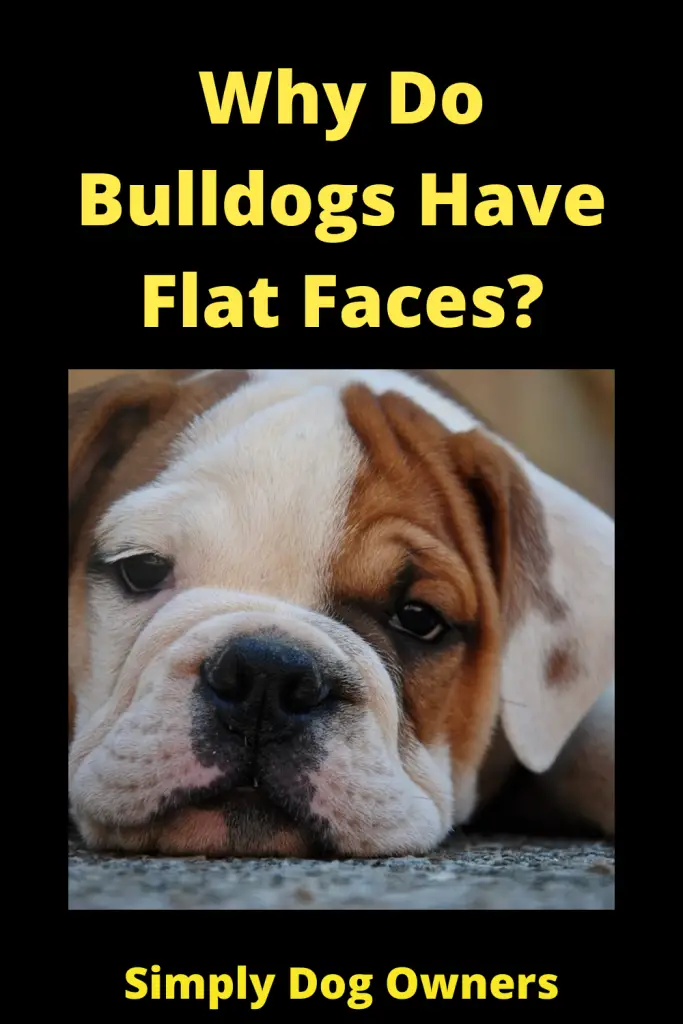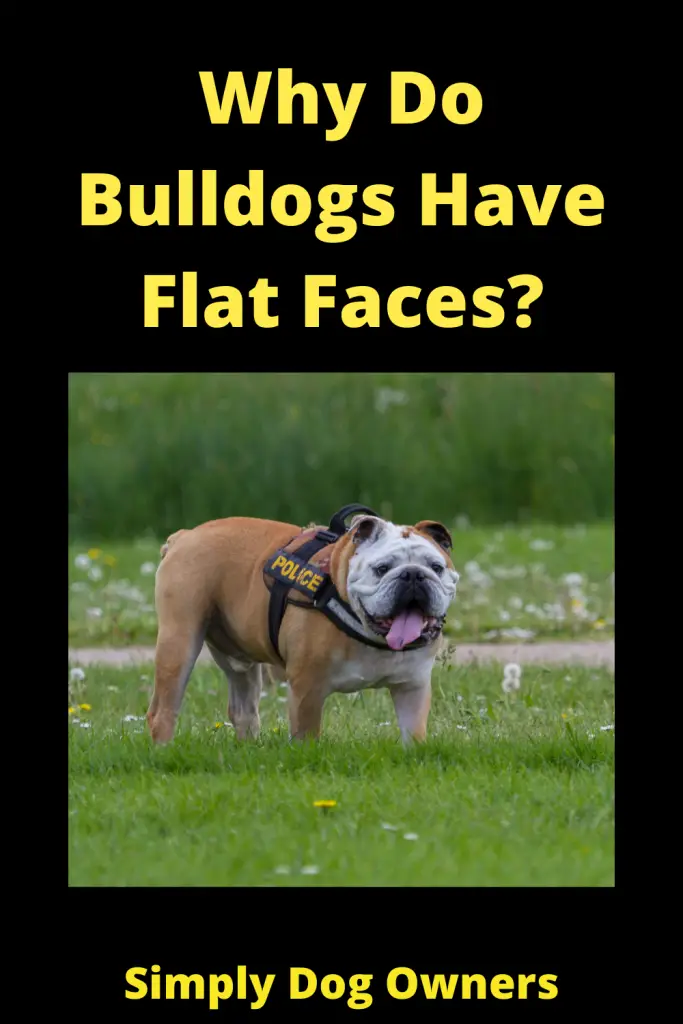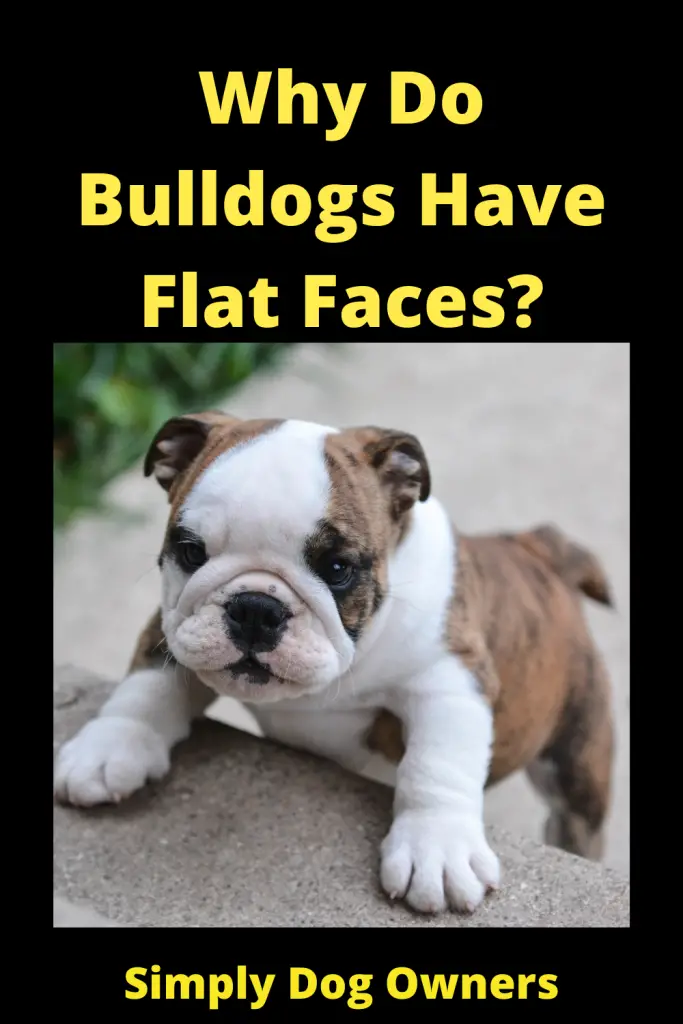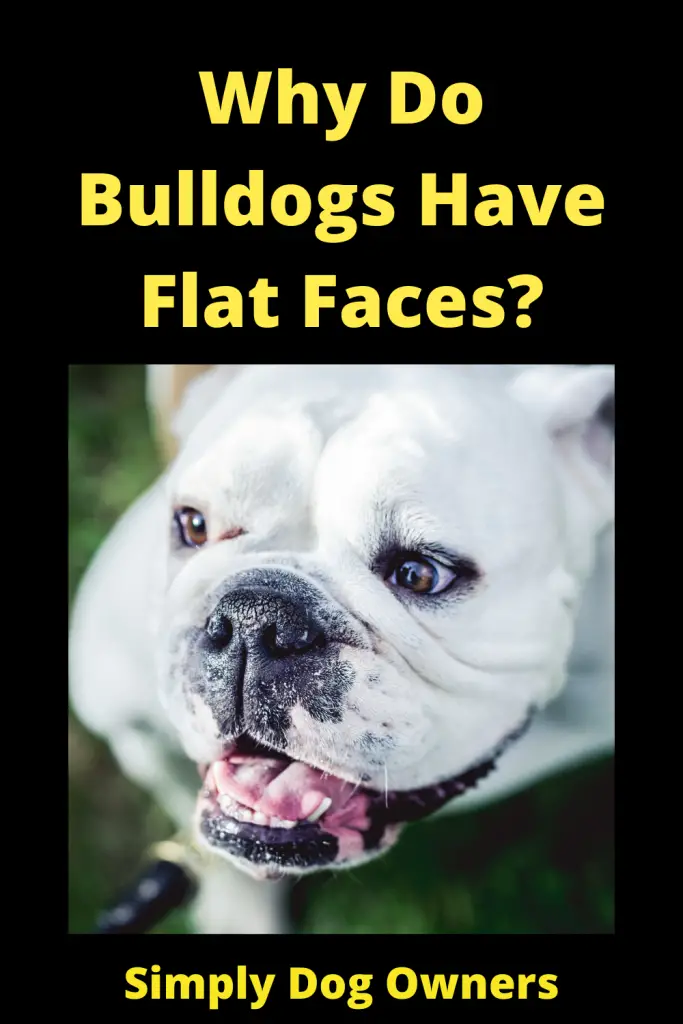Why Do Bulldogs Have Flat Faces?
Why do bulldogs have flat faces? There are the distinguishing characteristics of a Bulldog’s muzzle. Brachycephalic is the clinical term for dogs with a flat skull. The underbite, the drooping lips. It’s just too good to be true. Bulldogs are one of the top five dog breeds in America. The flat face has a lot of fans.
Why are bulldogs’ faces too flat? Bulldogs are classified as brachycephalic dogs, which means they have a flat muzzle. A hereditary disorder, according to veterinarians and experts, is to blame. Since the flat face was common, bulldog breeders used extreme breeding methods, selecting only dogs with this mutation to breed.
The flat-shaped face dog breeds like bulldogs have been linked to genetic variation and selective breeding by researchers and veterinarians. Since the flat-face phenotype was common and beneficial for bull baiting, the bulldog breed was made for; breeders used selective breeding to move it on.

According to experts, selective breeding has long been blamed for dog breeds’ flat-faced appearance like bulldogs. However, scientists have continued their studies to determine the precise DNA origins that trigger bulldogs’ flat faces.
A new DNA research report has brought scientists one step closer to identifying the genetic defect that causes bulldogs to have flat faces. Scientists from the University of Edinburgh’s Roslin Institute analyzed DNA samples from 374 companion dogs of various breeds in a 2017 report. They were able to compare the pet dogs’ genomic details and skull measurements.
Scientists discovered DNA differences linked to various head forms as a result of this research. The researchers found that one variation interrupted the function of a gene called SMOC2, which is connected to the duration of a dog’s muzzle.
Dogs with the mutation have flatter faces than dogs without the mutation. As a result, the flatter the dog’s head is, the further the mutation locks back the SMOC2 gene.
What are the Downsides of Dogs with Flat Faces?
There are some disadvantages of dogs having flat noses, such as bulldogs. According to Blue Cross for Pets, dogs with flat faces are more prone to health issues, the most serious of which being respiratory difficulties. Flat-faced dogs are more likely to inherit a disease known as brachycephalic syndrome.
They can’t breathe correctly because of this disease. Flat-faced brachycephalic breeds’ windpipes are generally narrow, limiting their oxygen consumption. Breathing issues with brachycephalic dogs are often exacerbated by their compressed nostrils, making it impossible for them to breathe properly.
Flat-faced dog breeds are often prone to heart attacks. Because of their reduced airways, bulldogs, for example, can not have adequate oxygen in their bloodstream. Furthermore, flat-faced dogs are prone to teeth issues.
They are more prone to have tooth issues like gum disease because their teeth are pushed to fit into a narrower surface region than dog types with longer snouts. Since their skulls are small, bulldogs and other brachycephalic species are more likely to have neurological disorders.
Unethical Breeding Practices for a Flat-faced Look
A bulldog’s physical characteristics set it apart from other dog types. Unfortunately, these characteristics render it vulnerable to immoral breeding activities. The issue is that some bulldog training has resulted in more unusual characteristics such as more significant and flatter ears. Bulldog breeding has focused on keeping the dogs’ heads bigger overtime to retain a marketable and desirable appearance.

How to Take Care of a Bulldog’s Flat Face
Since dirt will grow more readily inside the folds on your Bulldog’s flat face, it’s essential to take proper care of it. The wrinkles on a bulldog’s face may serve as a breeding ground for bacteria and other potentially dangerous germs.
As a result, a bulldog’s face should be washed daily to avoid diseases. As a result, cleaning the facial folds many times a week is necessary. To prevent irritations and skin infections, it’s vital to clean a bulldog’s face more often throughout the summer.
Start by washing each facial fold to remove bacteria and fragments while you scrub. Be sure to scrub each facial fold clean to avoid spreading bacteria and other germs. To stop irritation, make sure you strip extra moisture from your Bulldog’s flat muzzle. In the same way, don’t scrub your face too hard, which will irritate the skin.
Why are Flat-Faced Dogs so Popular?
According to studies, people like flat-faced dogs have many of the same characteristics as babies, such as big, wide eyes and appealing expressions. Short-faced dogs have skin folds because all of the soft tissue is still present when they are bred for a short face, so it has to wrinkle up to fit on the head.
The researchers have collected information about whether people stick with their flat-faced dogs. According to the parents, the dogs make excellent companions, are well-suited to limited living areas, and are good with children. With its stocky build, flat face, and underbite, the Bulldog is one of the most recognizable breeds. And what was once a stable, energetic dog has devolved into a small, stocky breed afflicted with health issues.
Despite health concerns, they have grown in popularity among dog owners, rising from the 16th most popular AKC registered breed in 2003 to the fifth most popular in 2014. While Bulldogs make wonderful companions in terms of personality, the breed’s numerous health issues have left many owners heartbroken. To some, the Bulldog is a cuddly barrel-chested companion, while to others, it is a symbol of all that is wrong with dog breeding.

Why do Bulldogs Have Wrinkles?
Bulldog puppies can develop into their wrinkles, and when they get older, the wrinkles will become less defined. This is all of the dog’s extra skin from birth. Some bulldogs will still have excess skin, but isn’t that cute? Only note to disinfect some wrinkles because they’re a bacteria breeding site.
Whether the dog develops a bacterial infection as a result of those adorable wrinkles not being adequately cared for, it would be a lot more trouble than cleaning the wrinkles are in the first place. So, stay on the lookout, and you’ll spare yourself and your dog a lot of grief in the long run.
Are Bulldogs Dangerous?
Owing to their nature and attitude, bulldogs are not aggressive dogs at all. Since the Bulldog is more passive and easygoing than other dogs, it is more apt to lick a human than strike them. The Bulldog is the ideal dog for you if you choose a dog that can pull out the welcome mat rather than growl or bark at people.
A dog’s personality and temperament are what makes him dangerous. This can be the result of various factors, but it frequently begins with breeding the animals. Another factor determining whether or not a dog is dangerous is if its temperament and nature are unpredictable.
Apart from genetics, a variety of factors can influence their temperament, personality, and innate nature. Training, socialization, health concerns, the environment, stress level, and age can influence whether or not a dog is dangerous.

Many dogs of various breeds with a history of aggression are well-known for being the family’s babies. These dogs defy the stereotype of a dangerous breed. They could be physically large, have a deep and powerful bark, or possess other physical characteristics that make them appear dangerous. When it comes down, they are the pushover who lays on the floor for hours, savoring every second of the stranger’s belly rub.
Even better are dog breeds traditionally being companion animals and don’t appear to have a dangerous bone in their bodies. However, issues such as their upbringing, environment, health, and education were not adequately addressed. Then, they snap and turn into a dangerous or aggressive dog when an unsuspecting friend or relative comes to visit despite their heritage.
The point is that dangerous dogs come in all breeds, and any dog can be dangerous if the right set of circumstances exist. The Bulldog was bred for very dangerous things, and while they may be considered dangerous if we follow their historical background, they are not in general dangerous.
They will thrive if they are raised with love and attention from the time they are a puppy. They will develop into excellent dogs if they are kept healthy and given consistent and thorough training and socialization from a young age.
They will be content if their home environment is full of love and attention, and they are not neglected, mistreated, or abused. They are happy, loving, and friendly if they are kept as stress-free as possible while receiving positive reinforcement of what is expected of them and regularly reviewing social skills. This is a recipe for true happiness for any dog breed, not just the Bulldog.
What Can Make a Bulldog Dangerous?
Different situations can make any dog unsafe, and each dog is additional. Besides good socialization, exercise, and plenty of affection and enjoyment, specific experiences or circumstances will cause a dog, regardless of type, to behave in a risky way. The causes for each dog are different. It is simpler to avoid episodes if you are familiar with the dog’s disposition and attitude.
The mailman dropping off the mail, the housecat scratching their ear, so much wrestling with the family’s children, unusual smells, or noises are both examples of situations and scenarios. When a dog’s trainer learns to know their dog, they’ll be more prepared to deal with situational violence problems, which can make any dog risky.
The Bulldog has been trained for several years to be a social, respectful partner to humans. This makes a good choice for any family looking for a puppy. Although they have a protective streak for other dogs or livestock, they are not aggressive in general.
When it comes to training the Bulldog, conscientious breeders who care for the breed want the right dog to breed. This involves selecting pets of a milder disposition to produce a Bulldog that is both polite and calm. The violent component of the genetic heritage is unavoidable.
How Often Should You Wash a Bulldog?
A Bulldog must be bathed and groomed regularly. Depending on his lifestyle, this gentle yet courageous dog can be washed as often as once a week to once every six weeks. Bathing this smooth-coated breed regularly is necessary to keep the skin and coat healthy. To achieve good results, you must choose the right products for your pet’s skin and coat.
Before bathing your Bulldog, use a high-velocity dryer to loosen any dirt and dander from the skin and remove any excess loose coat. To help with shedding, lightly card the coat. It’s bath time for your Bulldog now that you’ve chosen the best products for him!
The facial area is one area where you should pay special attention to detail. With a facial cleanser, you can concentrate on the entire facial surface as well as any wrinkles. Any wrinkle, no matter how minor, will harbor bacteria. It’s critical to pay close attention to those areas. The facial scrub can be used during baths to keep skin fresh and clean while also removing new stains.

Breathing Problems with Flat-Faced Dogs
Despite how adorable the Bulldog’s flat face is, it causes a slew of health issues. The most serious of them is brachycephalic airway syndrome. One or both of these issues might be present in a dog with brachycephalic airway syndrome.
- Stenotic Nares –When the nostrils are small and narrow, this is known as stenosis. As a result, airflow is restricted.
- Soft Palate Elongated – The soft palate is the part of the soft roof of the mouth. Their mouth is too big for their palate. The trachea at the back of the mouth is thus blocked.
- Hypoplastic Trachea – Because of the long soft palate pressing into the throat’s back, the windpipe has a smaller diameter.
- Everted Laryngeal Saccules – Everted laryngeal saccules are small sacs located in the voice box. When the dog breathes harder, they turn outwards and are sucked into the airway. The stenotic nares aren’t helping matters.
Both of this stuff obstruct a ton of ventilation, and it’s all down to bulldogs’ flat faces. Breeders are also attempting to find the healthiest pets for reproduction and excluding severely brachycephalic dogs from the breeding population, which is a good thing. Be sure to discuss this health issue with your breeder, as well as the parents they’ve chosen.
What is a Bulldog Mixed With?
The Bulldog is said to have originated in the British Isles. The Asiatic mastiff and the Pug are thought to be their ancestors. Bulldogs have initially been fearless and pain-insensitive dogs. They will hit the bull from beneath, then aim for the jugular in the stomach, rendering the bull defenseless. Bulldogs were raised for domesticity when dog fighting became illegal in England.
Health Difficulties with Flat-Faced Dogs
Short-nosed dogs do not all develop health issues due to breeding, but many too many do. Our Blue Cross veterinary hospital teams see several brachycephalic dogs with a range of issues related to breeding with a distinctive flat-face if these breeds become more common.
Breathing problems
In flat-faced dogs, brachycephalic obstructive airway syndrome (BOAS) – also recognized as a brachycephalic syndrome – is usual. For dogs with this syndrome, breathing naturally is often a challenge.
There are a few explanations that this syndrome causes these dogs’ respiratory problems:
- Flat-faced dogs have thinner muzzle bones in their skulls than dogs with typical longer snouts, yet the soft tissue around the jaw, nose, and neck is also not smaller. As a result of the increased skin and other soft tissue in these regions, the airway narrows or becomes partly obscured as the tissue squeezes into a narrower room.
- In brachycephalic dog breeds, the windpipe is often deformed and compressed, allowing for less air to be drawn in with each breath.
- Dogs are unable to sweat and must rely on panting to control their body temperature. Shorter-nosed dogs cannot cool themselves off as easily as dogs with a typical longer muzzle would by sucking in the air over the vast surface region of the tongue. Brachycephalic dog species are more prone to overheat as a result of this. Hot weather may also kill some people, mainly if they are overweight or older.
- A dog’s nose is one of two places to provide oxygen; the other is by the teeth. Narrowed nostrils, also known as stenotic nares, are more common in brachycephalic dogs, making inhaling more challenging.
Heart Problems
Shortened and compressed airways trigger labored breathing, making it difficult for these dogs to deal with a shortage of oxygen in the bloodstream. This puts a burden on the dog’s heart, making them more prone to secondary heart issues.
Tooth Problems
Dog varieties have been selectively bred with specific traits over several years, and those bred for a shorter upper jaw also have the same amount of teeth as those of their genus with longer snouts (42 teeth in adult dogs). Their teeth may clash, and they have to accommodate all teeth into a much narrower space, raising the likelihood of decay and gum disease.
Skin and Ear Problems
These dogs often have deep skin folds around their eyes and ear canals narrowed because of their head form. These environments are badly ventilated, which encourages yeast infections, causing them to become very swollen.
Eye Problems
Since all of these pets have large pupils, their tear film does not extend evenly, leaving them susceptible to injuries. They are prone to developing eye ulcers, which may lead to an eye’s loss if left unchecked.
Mating and Giving Birth.
Some brachycephalic dogs have a hard time giving birth spontaneously in large numbers. Since selective selection has resulted in a disparity between the puppies’ big heads and the mothers’ birth canal, English and French bulldogs often need Caesarean sections before their pups are about to be born. Dystocia owing to fetal-pelvic disproportion is what veterinarians term it.
Although some bulldogs will give birth spontaneously, in the United Kingdom, 86 percent of Bulldog puppies and over 80% of French bulldog puppies are born by C-section. These bulldog moms would more likely die of distress during delivery if they didn’t have aided deliveries, and their children would be unable to live as well. Caesareans are effective procedures on any puppy, although the risk is higher for those with brachycephalic breathing issues.
Neurological Problems
Because of their usually compact skull form, brachycephalic breeds may suffer from neurological (brain) issues. The most frequent of these is syringomyelia, a debilitating disease in which cavities or cysts develop in the spinal cord. Cavalier King Charles spaniels are the most popular carriers.
Final Thoughts
Because of their distinct characteristics, bulldogs and other flat-faced dogs have started to gain prominence. Bulldogs are known for their flat faces, which have made them immensely famous. However, it’s essential to be aware of the health risks involved with bulldogs’ flat faces. Because of the composition of their faces and their materials, bulldogs are especially susceptible to various health problems if not well cared for. As a result, adequate treatment should be given to them. Cleaning their flat faces regularly is also vital for their welfare.

